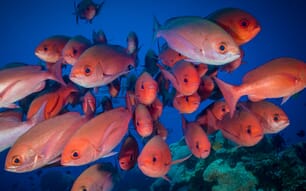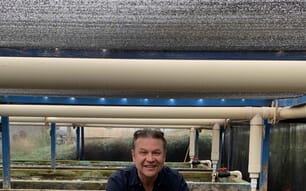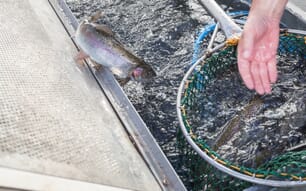Although tilapia breed freely in ponds, it is important for farmers (producers) to consider using properly produced fingerlings. They need to invest in hatcheries for fry and fingerling production. Quality fingerlings in tilapia aquaculture are very important. For this reason it is advisable for farmers to generate their own fingerlings if they can not ascertain the quality of those from other sources. Poor fingerlings result in poor harvests.
Developing a hatchery will allow the farmer to have ready fingerlings whenever he needs them. As long as the demand for fingerlings exists, a well-managed hatchery can turn out to be a good business.
Three methods of tilapia fingerlings production are commonly practiced in Kenya. These are:
- Open ponds (the most commonly used)
- Tanks
- Hapas (net enclosures) placed in ponds
For these methods, fry are collected from the spawning units and stocked into fertilized ponds for rearing to the fingerling stage before they are stocked into grow out ponds.
Open Pond Method
This is the simplest and most common method of tilapia fingerling production in Kenya. A properly constructed and well fertilised pond serves both for breeding and rearing fry. Brooders are stocked into the ponds and allowed to spawn naturally. The brood fish are stocked at the rate of 100 to 200 kg/ha at a sex ratio of 1:3 or 1:4 (males to females). A female brood fish of 90-300 g produces as much as 500 eggs per spawning. They should produce 6 - 15 fry/m2/month. To increase seed production, use larger brooders. Brooders of 1 - 1.5 kg can produce 45 fry/ m2/month. For this case, you need to harvest every 17-19 days.
Harvesting fry from the ponds is done every 15 - 21 days (More frequently where average water temperatures are above 25°C). The brooders can be used for 3 - 5 years. Fry harvesting should be done by hand scoop nets along the edges of the pond to minimise pond disturbance and fry mortality.

Tank-based hatcheries are relatively expensive to set up. The tanks should be circular in shape and can be made of concrete, plastic, fibreglass or even metallic..
When using this method:
- The tanks should be 1-6 m diameter and a water depth of 0.5-1 m.
- Stock 100-200 g brooders at a density of 3-5/m2 at a sex ratio of 1 male to 2-7 females.
- Feed using a 30-40% crude protein diet at a rate of 1-2% body weight/day.
- Collect fry every 10-14 days
Yields of up to 400-3,000 fry/m2/month can be realised using this method.
An advantage of using the tank method is that they are easy to manage. On the other hand, tanks are often relatively expensive to set up compared to ponds and hapas.
The 'Hapa' Method
A hapa is a cage like, rectangular or square net impoundment placed in a pond for holding fish for various purposes. They are made of fine mesh netting material. The mesh size is such that the fry or fish inside can not escape.
Hapas sizes vary but the ideal size measures 3 m long, 3 m wide, and 1.5 m deep.
When using hapas to generate fingerlings:
- Stock brooders used should be weighing about 100 to 200 g at a ratio of about 1:5 to 1:7 males to females.
- Stock the brooders at a density of 4 - 5 brooders / m2.
- Hapas should be inspected for fry every day
- Remove the fry using a scoop net after two week and stock them into tanks, other hapas, or a rearing pond.
Production in hapas range from 150 fry/m2/month to over 880 fry/ m2/month.
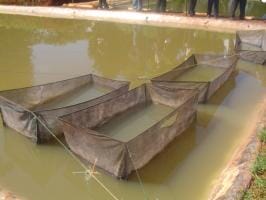
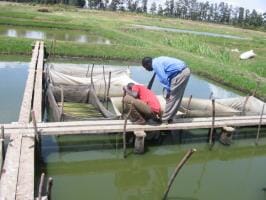
Feeding
- Fry reared in a hapa should be fed 4 times/day on a daily basis until the fry reach the desired size (5 g).
- Use a diet in powder form at the rate of 5-10% of the total body weight per day.
Advantages of using this method are
- Fry and brooders are easily handled
- Production on a per unit area is high.
- Assurance of uniform fry of relatively the same age
- Minimised lose of fry
- Hapas can be set up in ponds stocked with fish
Disadvantages of the hapa method
- Management is more demanding compared to the other methods
- Mortalities may occur due to agressiveness during spawning
- Feeding is a must
- Hapas can be destroyed during stormy weather
- Hapa material will degrade in sunlight and need replacing
- Fish may easily escape if the hapa is damaged
- Localised poor water quality is likely due uneaten feed and fish waste
- Hapa mesh will get clogged limiting water circulation and need periodic scrubbing
Production of All-Male Fingerlings
Males-only fingerlings can be obtained by three methods:
- Hybridization. Hybridization can be used to produce better results of males only. The hybrids can then be subjected to hand sexing a sex-reversal treatment. Producing sufficient numbers of hybrid fry maybe difficult because of breeding incompatibilities between the parent species.
- Sex-reversal. Sex-reversal is more complicated and requires obtaining recently hatched fry and rearing them in tanks or hapas where they are subjected to hormone laced feed for about three weeks.
- Manual sexing. Manual sexing (hand sexing) involves separating males from females by visual inspection of the external urogenital openings. Secondary sex characteristics may also be used to help distinguish sex. Reliability of sexing depends on the skill of the workers, the species to be sorted and its size.
Experienced workers can easily sex 20-gram fingerling T.hornorum and T.mossambica, 30-gram T. nilotica, and 50-gram T. aurea.
None of these methods is always 100 percent effective, and a combination of methods is recommended.
Hormonal Sex Reversal
- To do this, you need a tank-based or hapa-based hatchery that will allow fry to be collected at the yolk sac or first feeding stages (no later than one week after they have been released from the female).
- Transferred healthy fry of uniform size to the tank or hapa where you will feed them with hormone-laced diet for 21-28 days
The sex reversal feed is prepared as follows:
- Mix 30 - 70 mg of hormone (methyl or ethynyl testosterone) in 700 ml of 95% neutral ethanol
- Add 700 ml of hormone solution to each kg of finely ground feed then mix thoroughly and dry. At this stage you may add any needed supplements
- This feed should be kept under refrigeration if it is not going to be used immediately
- Feed the fry at a rate of 10 - 30% of body weight per day, at least four times a day for 21 - 28 days.
- The fry must eat this feed to sex-reverse
Tilapia males are preferred for culture because they grow faster than females. Females use considerable energy in reproduction and do not eat when they are incubating eggs.
Males only culture permits the use of longer culture periods, higher stocking rates and fingerlings of any age. High stocking densities reduce individual growth rates, but yields per unit area are greater. If the growing season can be extended, it should be possible to produce fish of up to 500 grams. Expected survival for all-male culture is 90 percent or greater.A disadvantage of male mono-sex culture is that female juveniles are discarded.
Females included in a population of mostly male tilapia affect the maximum attainable size of the original stock in grow-out. A stocking rate of 2/m2 is commonly used in Kenya to achieve yields of 1kg/m2. At this stocking rate the daily weight gain will range from 1.5 to 2.0 grams. Culture periods of 6 months or more are needed to produce fish that weigh close to 500 grams. There are cases in Kenya where stocking densities of 6 juveniles/m2 is practiced with a production of up to 3kg/m2. Higher stocking densities will require water aeration and sub-optimal feeding rates may have to be used to maintain suitable water quality.
You might also be interested in:
- How to Construct a Semi-intensive Pond for Aquaculture
- How to Achieve Good Water Quality Management in Aquaculture
January 2015
This article was taken from Infonet-Biovision.org.

